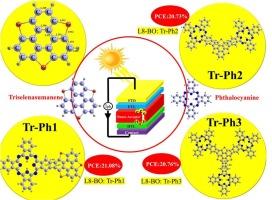酞菁功能化三硒人烯分子作为钙钛矿和有机太阳能电池供体材料的多功能空穴传输材料的设计与评价:一项DFT研究
IF 4.6
2区 物理与天体物理
Q2 MATERIALS SCIENCE, MULTIDISCIPLINARY
引用次数: 0
摘要
本研究旨在设计和引入基于三烯亚丁烯(TRSS)的多功能有机分子,TRSS被1至3个有机酞菁单元(Tr-Ph1至Tr-Ph3)功能化,用于有机太阳能电池(OSCs)和OSCs和钙钛矿太阳能电池(PSCs)中的空穴传输材料(HTMs)。采用DFT和TD-DFT方法,结合B3LYP泛函和6-31G(d,p)基集对结构进行优化分析。结果表明,增加酞菁单元数可显著减小TRSS的能隙(从4.29 eV降至1.97 eV),最大吸收波长发生强烈红移,吸收强度增强(超过三倍),偶极矩增加,第一激发能降低(近一半),光收集效率(LHE)提高一倍,结合能降低,λe/λh比提高近一倍。这些发现支持了设计的分子在OSCs和psc中作为供体的适用性。采用ITIC、tic - th、Y6、L8-BO和BTP-eC9等受体的Osc模拟表明,L8-BO:Tr-Ph1的PCE最高,达到21.08%。此外,HOMO-LUMO与MAPbI3和FAPbI3的比对证实了它们作为html的潜力。这些分子的高效率、合成可及性、无毒性、多功能性和环保性为下一代osc和psc提供了一条有前途的途径。本文章由计算机程序翻译,如有差异,请以英文原文为准。

Design and evaluation of phthalocyanine-functionalized triselenasumanene molecules as multifunctional hole transport materials in perovskite and donor materials in organic solar cells: A DFT study
This study aims to design and introduce multifunctional organic molecules based on Triselenasumanene (TRSS) functionalized with one to three organic Phthalocyanine units (Tr-Ph1 to Tr-Ph3) for potential use as donors in organic solar cells (OSCs) and hole transport materials (HTMs) in both OSCs and perovskite solar cells (PSCs). Using DFT and TD-DFT methods with the B3LYP functional and 6-31G(d,p) basis set, the structures were optimized and analyzed.
The results showed that increasing the number of Phthalocyanine units significantly reduces the energy gap (from 4.29 eV for TRSS to 1.97 eV for Tr-Ph3), induces a strong red shift in maximum absorption wavelength, enhances absorption intensity (over threefold), increases dipole moment, decreases the first excitation energy (nearly half), doubles the light-harvesting efficiency (LHE), reduces binding energy, and nearly doubles the λe/λh ratio. These findings support the suitability of the designed molecules as donors in OSCs and HTMs in both OSCs and PSCs.
Osc simulations with acceptors such as ITIC, ITIC-Th, Y6, L8-BO, and BTP-eC9 showed that L8-BO:Tr-Ph1 achieves the highest PCE of 21.08%. Moreover, HOMO–LUMO alignment with MAPbI3 and FAPbI3 confirms their potential as HTMs. The high efficiency, synthetic accessibility, non-toxicity, multifunctionality, and eco-friendly nature of these molecules offer a promising path for next-generation OSCs and PSCs.
求助全文
通过发布文献求助,成功后即可免费获取论文全文。
去求助
来源期刊

Results in Physics
MATERIALS SCIENCE, MULTIDISCIPLINARYPHYSIC-PHYSICS, MULTIDISCIPLINARY
CiteScore
8.70
自引率
9.40%
发文量
754
审稿时长
50 days
期刊介绍:
Results in Physics is an open access journal offering authors the opportunity to publish in all fundamental and interdisciplinary areas of physics, materials science, and applied physics. Papers of a theoretical, computational, and experimental nature are all welcome. Results in Physics accepts papers that are scientifically sound, technically correct and provide valuable new knowledge to the physics community. Topics such as three-dimensional flow and magnetohydrodynamics are not within the scope of Results in Physics.
Results in Physics welcomes three types of papers:
1. Full research papers
2. Microarticles: very short papers, no longer than two pages. They may consist of a single, but well-described piece of information, such as:
- Data and/or a plot plus a description
- Description of a new method or instrumentation
- Negative results
- Concept or design study
3. Letters to the Editor: Letters discussing a recent article published in Results in Physics are welcome. These are objective, constructive, or educational critiques of papers published in Results in Physics. Accepted letters will be sent to the author of the original paper for a response. Each letter and response is published together. Letters should be received within 8 weeks of the article''s publication. They should not exceed 750 words of text and 10 references.
 求助内容:
求助内容: 应助结果提醒方式:
应助结果提醒方式:


